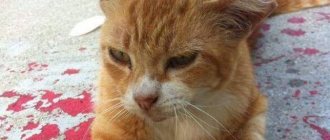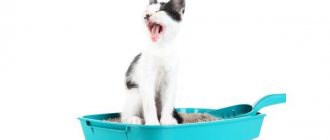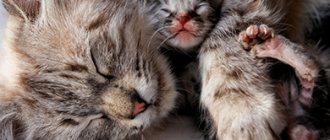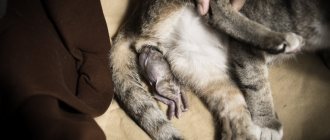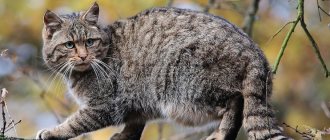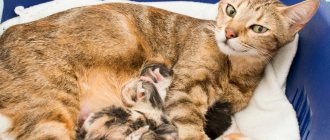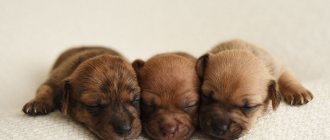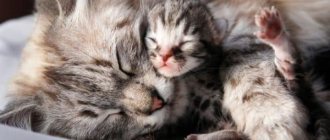7870Administration
The birth of kittens and postpartum recovery of the body are considered normal events in the life of a cat who has given birth. And if a cat has bleeding after giving birth, then this can be considered a natural process that accompanies the removal of remaining tissue, blood and mucus from its body. However, situations in which such discharge appears too long after the animal has finished giving birth require certain actions on the part of the animal owner to prevent possible adverse reactions to the health of the pet.
What kind of normal discharge are they?
The first thing an owner can and should do is to carefully observe a cat that has just gone through childbirth. It is important to monitor her body temperature and secretions.
At first, a cat may have discharge after giving birth, blood may even flow, and if the body temperature does not rise, the cat is active and alert, takes care of the kittens and itself, then there is no need to worry, such discharge is normal.
After childbirth
Childbirth has recently passed, and the uterus contracts, while the remaining mucus is pushed out. Postpartum discharge of this type can normally continue for up to 21 days, during which time the pet should fully recover.
In the very first days, a cat’s discharge after birth may be red or brown, and may even contain green inclusions and veins; all these are normal variants. A “metallic” smell is also allowed, but foreign odors may be alarming.
Video “Birth of a kitten”
The first sign of the impending birth of a kitten is light, and then darker discharge, and a little later - attempts. The kitten is born approximately 25–35 minutes after the onset of such manifestations. The baby is born in the amniotic sac, which the cat bites through and then licks its face to remove mucus and open its nose for breathing. After this, it gnaws the umbilical cord and licks the entire body, activating blood flow and other vital functions.
Depending on how the cat’s birth progresses, you need to either not interfere or start helping. If the woman in labor manages to “process” each kitten before the next one arrives, then nothing needs to be done. When she failed to cope with one, and the birth of another baby has already begun, the algorithm of actions should be as follows:
- carefully release the kitten from the film and gently rub it with a sterile cloth;
- tie the umbilical cord with dental floss, cut it off and treat it with an antiseptic solution;
- make sure the newborn is breathing and place him next to his mother.
If there is no breathing, the airways should be cleared with a baby syringe. If this does not help, carefully turn the baby upside down, supporting the head, and bend it slightly, stimulating the outflow of fluid.
We do not recommend watching this video for impressionable or faint-hearted people - it shows the process of giving birth to a kitten and how the cat cares for it immediately after birth.
Popular articles:
- How much does it cost to remove a cat's stitches after sterilization?
- Dry cat food for removing hairballs
- How do you say a cat has green eyes in English?
- Royal Canin for kidney failure for cats reviews
- Dironet spot it for cats instructions for use
Dangerous secretions
Sometimes childbirth is complicated, tissue is damaged and infection occurs; in all these cases, the discharge is prolonged and there is an odor. All this is already a reason to contact a specialist. During difficult births, the birth canal ruptures, the release of kittens or placenta may be delayed and this also provokes the onset of bleeding. Prolonged and severe bleeding can be fatal, so as soon as you suspect something is wrong, you should contact a veterinarian for help. Bleeding should not last more than 10 minutes; if during this time you see blood that is bright scarlet in color and it is difficult to confuse it with normal postpartum discharge, you will need help. It is also needed if mucus is released abundantly and a large number of clots are present.
If the discharge with blood is thick and has greenish inclusions, this indicates that inflammation is taking place in the walls of the uterus. The cause may be an incompletely released placenta or infection from the environment. Therefore, it is important to keep the cat’s “nest” clean. You can put a clean diaper under it; with normal discharge, such bedding will be enough for half a day.
What should the owner do?
The owner, if various types of secretion are detected and during difficult births, should not:
- Interfere. Every cat knows how to give birth, it’s nature’s way, and she knows what she’s doing and completely trusts her body.
- Panic. This will not help, but will only worsen the nervous condition not only for you, but also for your pet.
On the contrary, the owner should always be on hand, take care of his tailed dog and support it in every possible way. Don't escalate the situation, but help. Provide assistance, consult a doctor, and do not skimp on medications if necessary. Give your pet everything to make her feel better. Do everything in your power for her.
Frequent injuries after childbirth
You can suspect postpartum injuries if there are the following signs in your cat’s behavior.
- Heart rhythm is disturbed.
- Breathing becomes rapid, and after a while shallow breathing can be observed.
- The cat is acting restless.
Typically, such symptoms are observed when tissue ruptures. If the bleeding is not severe, the doctor may prescribe medications to help stop the bleeding. If the bleeding is severe and does not stop for a long time, then surgery will be required and it is important to contact a veterinarian as quickly as possible.
Discharge in a pregnant cat
Pregnancy lasts 9 weeks and consists of the following periods:
- From 0 to 3 weeks, the embryo is fertilized and attaches to the wall of the uterus.
- From 4 to 6 weeks, the uterus increases in size, the embryos grow, and are determined by palpation.
- From 7 to 9 weeks, the embryos are fully formed, and the female prepares for childbirth.
The 2nd and 3rd periods are the most dangerous, the cat sheds the fetus prematurely or contractions begin, the kittens are born premature.
Brown discharge at any time alerts doctors; darkening is a sign of placental abruption and fetal death in the womb. A dangerous situation for the body occurs during intoxication, so that the woman in labor does not die, doctors provide assistance to her.
Late treatment results in the death of the pregnant female and kittens.
Adviсe:
- Pregnancy is planned according to the rules after consultation with a veterinarian, all vaccinations are given, and vitamins are taken.
- The animal is kept away from drafts and sudden changes in temperature are prevented.
- The owners treat the cat carefully and do not touch the abdominal area.
- Attention is paid to all deviations from the norm.
- The pet's condition is always monitored.
Danger signs:
- Scarlet blood indicates tissue damage; if it flows for about 10 minutes, you need to seek help from a surgeon to stop the bleeding.
- Placental abruption occurs in the 2nd stage of pregnancy.
- Green mucus with a disgusting odor comes out after the embryo dies. The body of the expectant mother is exposed to toxins, works poorly, kidneys, liver and other systems fail.
- Impurities of pus indicate inflammation, an examination is carried out by a veterinarian, therapy is prescribed to save the pet’s life, and antibiotics are used. Termination of pregnancy is performed in the most difficult situations.
Bloody discharge before birth in a pregnant cat appears after rupture of the uterus or other internal organs. Comprehensive tests and ultrasound examination are carried out in case of detachment, the cat is observed by a doctor before the onset of labor.
The veterinarian looks for dead fetuses in the abdomen and performs a cesarean section or premature birth if found. The cat's health cannot be saved without surgery if the kitten dies in the womb.
Diarrhea is often confused with discharge from the loop; digestive problems are resolved with the participation of a veterinarian, since they affect the development of the embryos. Amniotic fluid and other secretions are examined after birth, the veterinarian studies their properties and prescribes medications.
Inflammation of the uterus - signs
It happens that the infection enters the birth canal, causing inflammation of the uterine mucosa. This can happen both during childbirth and after it. Only on the 10th day will the cervix be completely closed, and until then the cat remains vulnerable to infection. In addition, the body is exhausted after childbirth, which means there is not enough strength to fight various infections. The main signs of inflammation, of course, include thick and frequent discharge; their color can range from bloody to greenish. The animal's body temperature rises and can reach 40.5 degrees. The cat is lethargic, does not take care of itself and the kittens, and mostly lies down. Of course, you need specialist advice. After conducting an examination, he will prescribe a drug such as oxytocin, which promotes faster contractions of the uterus. A course of antibiotics may also be needed. In any case, you should not self-medicate, as this can lead to the death of the animal. In this case, the kittens must be taken away from their mother immediately, because... they will have to be fed artificially, at least until the animal undergoes treatment.
A cat gives birth: only calm
One of the most significant and exciting events for a caring owner is the birth of a cat. Especially if this event happens for the first time. During the birth process, the cat may need help, so it is better to prepare for it in advance.
We recommend reading: Why Broilers Close Their Eyes
How to determine that labor is coming soon?
Pregnancy and birth of a cat go quite quickly. In order not to miss an important moment, you need to carefully observe the behavior of your pet. Precursors of childbirth appear approximately two weeks before the event itself. The kittens in the mother’s belly are actively moving (no matter how many there are), and the cat begins to look for a secluded place. Immediately before giving birth, the animal’s behavior becomes even more characteristic:
Most cats of different breeds (for example, British) meow loudly in pain and try to hide. But it happens that even during contractions, right before the kitten comes out, the woman in labor is cheerful and playful.
What should the owner do?
When the harbingers of childbirth become obvious, it is necessary to prepare a nest in which the kittens and cat will live after birth. The main requirement for a house is privacy and protection from drafts. The nest should be closed from prying eyes. For this purpose, you can use a box or special cat houses. The entrance is made in the form of a small hole located at the level of the animal’s chest.
Before giving birth, you should also think about bedding. The bottom of the nest can be covered with a disposable diaper or soft paper (as needed). This first bedding will then have to be thrown away, so expensive materials are not needed here.
During contractions, animals behave differently. For example, most Scottish purrs are characterized by throwing. The animal can climb into the closet, under the bed, into the nightstand. In this case, you need to calm the expectant mother, move her to a prepared house and sit next to him while he
Source
Diseases accompanied by discharge
After giving birth, a cat may develop a disease such as vaginitis or inflammation of the genitourinary system. They are bothered by white discharge that has the consistency of milk. These diseases can be dangerous for cats, because... She has a weakened immune system after giving birth. For vaginitis, treatment may be prescribed, but the cat will continue to feed the kittens, provided that the milk is not lost. But if antibiotics are prescribed, you can forget about breastfeeding.
If you, as an owner, are embarrassed by the cat’s discharge after giving birth, then it is better to call a veterinarian at home so as not to separate the pet from the babies. Perhaps in your case everything is not so bad and she will be able to feed them.
Diagnosis and treatment
If the secretion alarms you, this is not a reason to put off going to the veterinary clinic.
The doctor will conduct an ultrasound, take all the tests, and prescribe examinations.
If the secreted secretion is not the most dangerous, and little blood comes out, the doctor will prescribe medications that will stop internal bleeding.
If too much blood is released, the specialist will perform an operation, the details of which will tell you everything.
If your cat has inflammation, she will be prescribed antibiotics to help the uterus cope with the disease. Antibiotics help the uterus to throw out the last ones from the body, if any, and establish an internal pleasant and safe microflora.
Vitamin complexes, immune-supporting drugs, and special dietary foods may also be prescribed in conjunction with the main treatment. Also, if the situation was too serious, you will have to be constantly examined by a veterinarian, approximately once every six months to a year, to rule out other diseases.
Follow all your doctor's instructions if your illness gets worse.
Postpartum period
As soon as the cat has given birth to all the babies, the postpartum period begins. Usually when everything is over, she is calm and relaxed, the animal spends a lot of time sleeping, restoring its strength. How can a caring owner help?
- It is imperative to make sure that the cat has given birth to all the babies. Feel her tummy, it is important that there are no placenta or unborn kitten left in the uterus.
- Pay attention to all the changes that occur in your pet after birth. What is her emotional state, how does she feel, the presence of discharge and changes in body temperature.
- There is no need to unnecessarily approach the kittens, pick them up, or examine them. The new mother worries about this, especially if strangers are interested in the babies.
- It is necessary to ensure cleanliness for the cat and kittens; clean rags or diapers must be laid in advance in the box where the family will live.
- Everything you need (toilet, bowl of food) needs to be moved closer to the box so that the mother is less away from the children.
Preventive measures and care
First of all, you should prepare for the cat's birth - first create a cozy and warm place, bring clean sheets, tampons and water.
It is necessary to control such things as the sterility of instruments and bedding during childbirth. Also, there should not be many people in the room where replenishment is expected. It’s better to have only the owner and the expectant mother.
To avoid all sorts of problems after the birth of cute whiskers, it is necessary to create comfortable and safe conditions for both cat generations.
- You need to regularly examine the mother cat and pay attention to the intensity, color and smell of the discharge.
- If your pet does not keep the family nest clean, then help her with this - the remaining mucus and blood need to be removed. Be sure to change the bedding and make sure that everything is clean under the mother's tail.
- Provide your cat family with peace and quiet - they need time to adapt to external changes.
- Do not touch the born babies - this causes anxiety in the mother cat, up to the loss of milk and abandonment of the cubs.
- Take care of a high-quality and balanced diet, because the new mother will eat more food. A plate with treats and clean water should always be near your pet. If after giving birth your pet refuses to eat for more than a day, you should call a veterinarian.
- Monitor your temperature throughout the recovery period. Normal temperature ranges from 38 to 39 degrees. A deviation from the norm is a reason to take your pet to the clinic or call a doctor at home.
A set of measures to prevent undesirable consequences of childbirth
When preparing for childbirth, even experienced animals experience fear and anxiety. The nervousness of the cat's mother can negatively affect the birth process.
You need to observe the animal unobtrusively, trying not to disturb
To reduce the likelihood of complications, it is necessary to prepare in advance for your pet a place that meets the following requirements:
- Accessibility for cleaning. You need to be able to clean the cat’s “nest” and at the same time disturb the mother and offspring as little as possible. A good option would be a mattress covered with an absorbent diaper.
- Space limitation. While crawling, newborns can fall off the bedding, and the kitten’s squeak unnerves the pet. If labor is not completed, the reaction to the baby's crying can cause complications. A large box or installation of limiting sides will do.
- No drafts. The immunity of both mother and cubs is still weak.
- Removing strangers. Extra people make the animal worry and try to hide the born offspring. Inexperienced cats can accidentally crush babies. In a calm environment, the pet will relax, give birth and settle down so that it is more convenient for newborns to suckle.
Please note: Stopping arterial bleeding from the vessels of the upper and lower extremities
A cat giving birth should have a bowl and a toilet next to the “nest”. The birth process can take several days and the cat's mother needs to ensure that her natural needs are met.
Prevention measures
Preventative measures will help prevent complications after childbirth:
- Do an ultrasound of the uterus of a pregnant cat to know the exact number of kittens and not worry that one of them remains in the womb or birth canal.
- Conduct an examination of the cat for the presence of pathologies, the exacerbation of which during pregnancy or during childbirth can threaten the health and life of the animal. If you have urolithiasis after childbirth, bloody mucus may appear in the urine, and during pushing, stones and sand may become dislodged. There is a high probability of damage to the genitourinary system. You will need to take a urine test and undergo an ultrasound of the kidneys and genitourinary system in order for the veterinarian to prescribe treatment.
- Properly care for your pregnant and postpartum cat. Provide her with peace, the help she needs, a balanced diet and enough fluids.
- Carefully monitor the condition of the body and behavior of your pet. Cover the box in which the mother and her offspring live with a white cloth to monitor the color and intensity of postpartum discharge.
When do you need veterinary help?
However, in many cases, postpartum discharge is one of the symptoms of serious pathologies. You should immediately contact a veterinarian in the following cases:
- If during the birth process the animal does not have all the placenta released. For example, a cat gave birth to five kittens, but three or four placentas came out. This condition threatens the pet with a dangerous disease - purulent inflammation of the uterus. This severe pathology often has to be treated surgically.
- If a large amount of discharge comes out of the loop, this most often indicates a disease.
- If an animal comes out with pus, this always indicates severe inflammation or tumor. Moreover, the pathological process does not always develop in the genitals. Such discharge may be a sign of bladder cancer.
- It is necessary to contact a veterinarian if discharge was observed during pregnancy.
- If an animal experiences heavy and prolonged bleeding, this should always be a reason to immediately contact a specialist.
- If a cat suffers from poor blood clotting, and after giving birth the animal experiences red discharge, this is a very ominous sign. With hematological pathologies, any damage received during childbirth can bleed for a very long time. In severe cases, the animal may die from blood loss.
- It is also necessary to urgently contact a specialist if discharge is observed after a difficult birth that occurred with ruptures of the mucous membrane. In such cases, cats often develop inflammation of the vagina - vaginitis.
- In rare cases, primiparous animals develop a fistula between the intestines and genitals. This is an extremely dangerous pathology that can be complicated by sepsis. In this case, not only blood is released from the loop, but also a small amount of feces.
- If your cat has had chronic urinary incontinence in the past, you should be examined by a veterinarian. In this case, urine constantly leaks and irritates the loop area. Over time, inflammation develops, accompanied by discharge.
Next, we will look at the different types of postpartum discharge and the possible reasons for their appearance.

